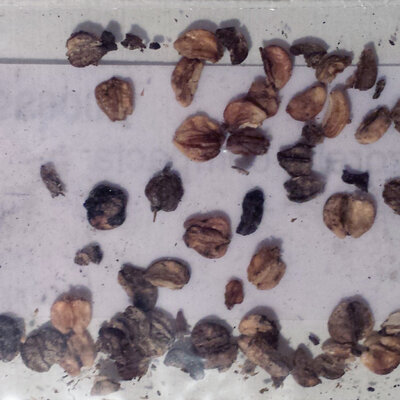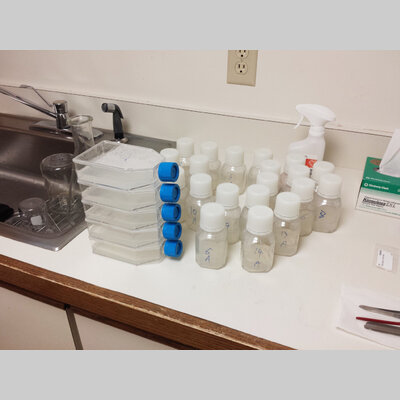germination the complicated way, pt. 1
2022/01/09
At some point this year I first read about Azorella Compacta, aka Llareta/Yareta, and immediately wanted one. They're fascinating, believed to live for thousands of years and grow in giant lumpy blobs. Unfortunately, as far as I can tell, nobody has ever tried to cultivate them (or at least, nobody has ever published anything, either academically or casually). Similarly, no plants have ever been for sale. Only one guy sells seeds occasionally, and since COVID-19, getting seeds out of Chile is impossible. Miraculously, I found some while looking for other cool plants, and for only an unreasonable sum of money, now have 30 seeds imported from Germany. While I was at it, I also grabbed some uncommon Tillandsia seeds.
now what?
So once you have seeds, you just stick 'em in some dirt and you get a plant. Except that only works if you have the right dirt, right temperature, right moisture levels, and are willing to accept the natural germination and attrition rate. Yareta seeds reportedly have an extremely low germination rate in situ, on the order of 0%. How can we stack the odds? Ideally, we need to control all parameters exactly and consistently, but also minimize effort. If only we could keep the seeds in a tiny, closed microcosm... and we can. Orchid hobbyists do this all the time, usually termed "flasking," since orchid seeds are very sensitive to mold and humidity. The general idea:
- clean the seeds
- stick them in a sterile jar with some nutrient goop ("growth medium")
- wait six months
In practice, it's a little more complicated. Keeping everything sterile is difficult, even with a fully equipped lab. The specifics of the goop vary by plant species. Some seeds have special requirements for germination. I'll discuss these separately for the two types of plants I want to grow (Azorella and Tillandsia).
tillandsia
These are fairly well-studied, and I found a number of papers examining the growth medium, temperature, light, effects of plant hormones, and so on. Some hobbyists do grow Tillandsia seeds in this way, since the seedlings are generally hard to keep alive for their first two years. My plan is to use 1/2 strength Linsmaier & Skoog (L&S) growth medium, with 15 g/L sucrose, and 0.5 mg/L gibberelic acid (GA). I'll keep them at room temperature with only low, indirect natural light until they've grown a bit, then give them a little more light.
azorella
This is harder, because it's a pretty obscure plant, and I haven't found any documentation of cultivation. I've looked at two general areas for more detail: details of their natural environment and growth patterns, and requirements of related plant species (Apiaceae, which includes things like fennel and carrots). The natural environment, by the way, is on and around exposed rocks, high in the Andes mountains. Some thoughts:
- seasonal temperature variation is modest (maybe 5 to 7 degrees C)
- temperature variation each day is a swing from cool to near freezing
- tons of intense sunlight all year, with lots of UV
- bad quality, rocky/sandy soil
- locations may be freezing for 3-5 months of the year
Some guesses:
- light is probably not required for germination
- a very long period (months) of cold stratification is probably required
- a standard growth medium is probably OK (at lower concentration)
- gibberelic acid may make germination happen slightly sooner
After reading dozens of papers, what does this mean? Anticlimactically, but conveniently, I'll use the same growth medium as for Tillandsia, and just stick them in the fridge for a few months. I'll note that this approach should work ok for most species, and I'm not doing anything particularly tailored (except the cold stratification). I was also given some Faucaria succulent seeds for free, which I'm going to throw in without any changes.
get the stuff
There are a few gotchas, mostly practical issues due to not having access to a full bio lab. The number one problem is contamination, i.e. mold. Fortunately, the most common sterilization technique for seeds is dilute bleach. Keeping them sterile is the challenge; a laminar flow hood is extremely useful, and most scientists also use an autoclave to sterilize tools and containers. It's possible to use a cheap pressure cooker as an autoclave, but I don't think it's really necessary here. Metal tools are pretty easy to sterilze. Mushroom hobbyists use a "still air box" with reasonable success rates instead of a real hood; a still air box is basically just a box with arm holes, and works on the principle of not moving air that carries spores/particulates into the sterile containers. Speaking of containers, it's very cheap to buy sterile tissue culture containers on ebay just because they're "expired" (past their certification date), or as lab surplus.
The next issue is that when mixing plant culture media, you're supposed to adjust the pH, which is done by measuring with a pH meter and adding appropriate amounts of hydrochloric acid and sodium hydroxide, neither of which I really want to work with. I found a nice cheap source of media that contains exactly what I want, and is also pH adjusted. They also have cheap agar and gibberellic acid solutions, which is everything else we need.
the protocol, vaguely
Trim excess fluffy bits from Tillandsia seeds. Rinse Yareta seeds.
Sterilize everything:
- bleach on all glass and metal
- wipe outside of all culture containers
Prepare the solution:
- heat up 2 liters of distilled water (agar dissolves into water starting at 90C) on stirrer hotplate
- add 14g of agar
- add the L&S mix
- let it cool a little (agar resolidifies around 50C)
- add the sugar (30g of sugar or 30 mL of simple syrup)
- once everything is nicely dissolved, pour into the prepared containers
- put them in the fridge to congeal more quickly
Then let it rest for maybe a week at room temperature to see if any are moldy (if so, toss them).
Prepare the seeds:
- wash seeds in 0.1% percent bleach solution for 2 minutes, then rinse in sterile water several times
- mix 1ml of 1mg/mL gibberellic acid solution intotwo liters of water
- put some of the seeds in containers with the GA3 solution overnight (then procede to next step with them)
- put the rest directly into the containers with the previously prepared agar
That's it!

